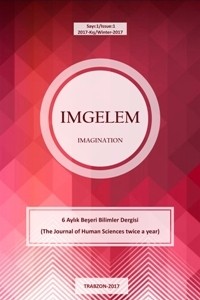TURİZMDE JEOSEMİYOTİK: BİR META-SENTEZ ÇALIŞMASI
jeosemiyotik, jeosemiyoloji, turizm ve jeosemiyotik, meta-sentez
GEOSEMIOTICS IN TOURISM: A META-SYNTHESIS STUDY
Geosemiology, Geosemiotics, Turism and Geosemiotics,
___
- Agnihotri, R. K., and McCormick, K. (2010). Language in the Material World: Multilinguality in Signage, International Multilingual Research Journal, 4(1), 55–81.
- Beck, C. T. (2002). A Meta-Synthesis of Qualitative Research, MCN, The American Journal of Maternal/Child Nursing, 27(4), 214–221.
- Berger, A. A. (2011). Tourism as a Postmodern Semiotic Activity, Semiotica, 2011, 183, doi:10.1515/semi.2011.006.
- Chumley, L. (2017). Qualia and Ontology: Language, Semiotics and materiality; An Introduction, Signs and Society, 5(1), 1–20.
- Denzin, N. K. (1987). On Semiotics and Symbolic Interactionism, Symbolic Interaction, 10(1), 1–19.
- Dowling, T. (2012). Translated For The Dogs: Language Use İn Cape Town Signage, Language Matters, 43(2), 240–262.
- Echtner, C. M. (1999). The Semiotic Paradigm: Implications For Tourism Research, Tourism Management, 20(1), 47–57.
- Ferenčík, M. (baskıda). Im/politeness On The Move: A Study Of Regulatory Discourse Practices İn Slovakia’s Centre Of Tourism, Journal of Pragmatics, 134, 183–198. doi:10.1016/j.pragma.2018.05.011.
- Fierman, W. (2009). Identity, Symbolism and the Politics of Language in Central Asia, Europe-Asia Studies, 61(7), 1207–1228.
- Grey, A. (2019). Tourist tongues: High-speed Rail Carries Linguistic and Cultural Urbanisation beyond the City Limits in Guangxi, China. Applied Linguistics Review, doi:10.1515/applirev-2019-0099
- Lamb, G. (2019). Spectacular Sea Turtles: Circuits of a Wildlife Ecotourism Discourse in Hawai‘i, Applied Linguistics Review, doi:10.1515/applirev-2019-0104.
- Lee, J. W., and Lou, J. J. (2019). The Ordinary Semiotic Landscape of an Unordinary Place: Spatiotemporal Disjunctures in Incheon’s Chinatow,. International Journal of Multilingualism, 1–17. doi:10.1080/14790718.2019.1575837.
- Lesh, K. N. (2019). Basque Gastronomic Tourism: Creating Value for Euskara through the Materiality of Language and Drink, Applied Linguisgics Review, doi: 10.1515/applirev-2019-0101.
- Lou, J. (2010). Chinatown Transformed: Ideology, Power and Resources in Narrative Place-Making, Discourse Studies, 12(5), 625–647.
- Lou, J. J. (2017). Spaces of Consumption and Senses of Place: A Geosemiotic Analysis of Three Markets in Hong Kong, Social Semiotics, 27(4): 513–531.
- Lourenção, M., de Moura Engracia Giraldi, J., and de Oliveira, J. H. C. (2020). Destination Advertisement Semiotic Signs: Analysing Tourists’ Visual Attention and Perceived Ad Effectiveness, Annals of Tourism Research, 84, doi:10.1016/j.annals.2020.103001
- Metro-Roland, M. (2009). Interpreting Meaning: An Application of Peircean Semiotics to Tourism, Tourism Geographies, 11(2), 270–279.
- Metro-Roland, M. M. (2011). Tourists, Signs and the City: The Semiotics of Culture in an Urban Landscape. Great Britain: Ashgate.
- Nikolaou, A. (2016). Mapping the Linguistic Landscape of Athens: The Case of Shop Signs, International Journal of Multilingualism, 14(2), 160–182.
- Noy, C. (2011). Articulating Spaces: Inscribing Spaces and (İm)Mobilities in an Israeli Commemorative Visitor Book, Social Semiotics, 21(2), 155–173.
- Parsaee, M., Parva, M., and Karimi, B. (2015). Space and Place Concepts Analysis Based on Semiology Approach in Residential Architecture, HBRC Journal, 11(3), 368–383.
- Peters, S. (2017). Sharing Space or Meaning? A Geosemiotic Perspective on Shared Space Design, Applied Mobilities, 1–21, doi:10.1080/23800127.2017.1386850.
- Pietikäinen, S. (2013). Spatial interaction in Sámiland: Regulative and Transitory Chronotopes in the Dynamic Multilingual Landscape of an Indigenous Sámi Village, International Journal of Bilingualism, 18(5): 478–490.
- Sowa, J. F. (2000). Ontology, Metadata and Semiotics, Conceptual Structures: Logical, Linguistic, and Computational Issues, 55–81. doi:10.1007/10722280_5.
- Thomsen, R. C., and Vester, S. P. (2015). Towards a Semiotics-based Typology of Authenticities in Heritage Tourism: Authenticities at Nottingham Castle, UK, and Nuuk Colonial Harbour, Greenland, Scandinavian Journal of Hospitality and Tourism, 16(3), 254–273.
- Thurlow, C., & Jaworski, A. (2017). The Discursive Production and Maintenance of Class Privilege: Permeable Geographies, Slippery Rhetorics, Discourse & Society, 28(5), 535–558.
- Torkington, K. (2014). Tourism-related Mobilities and Discursive Landscaping in the Algarve, Dos Algarves, 24, 40-63.
- Tsaur, S. H., Liao, Y. L. and Tsai, C. F. (2020) Analyzing the Important Implications of Tourism Marketing Slogans and Logos in Asia Pacific Nations, Asia Pacific Journal of Tourism Research, 25 (4), 355-368.
- Ye, Z., and Jeon, H.-Y. (2020). Chinese City Brands and Semiotic Image Scales: A Tourism Perspective, Social Semiotics, 1–24, doi:10.1080/10350330.2020.1769405.
- Zhang, X. and Sheng, J. (2017). A Peircean Semiotic Interpretation of a Social Sign, Annals of Tourism Research, 64, 163–173.
- Yayın Aralığı: Yılda 2 Sayı
- Başlangıç: 2017
- Yayıncı: Musa Yavuz ALPTEKİN
DÜZENSİZ GÖÇMENLERDE SOSYO-KÜLTÜREL ENTEGRASYON: ANKARA’DA YAŞAYAN AFGAN-ÖZBEK TÜRKLER
EBEVEYNLİĞE GELENEKSEL VE MODERN YAKLAŞIMLAR ÖLÇEĞİ’NİN GELİŞTİRİLMESİ: GÜVENİRLİK VE GEÇERLİK
SÜRDÜRÜLEBİLİR TURİZM ANLAYIŞI KAPSAMINDA BİR DESTİNASYON YÖNETİM MODELİ ÖNERİSİ
TURİZMDE JEOSEMİYOTİK: BİR META-SENTEZ ÇALIŞMASI
SOUND OF METAL FİLMİ ÖRNEĞİNDE BEDENE VEDA VE SESSİZLİĞİN SESİ
17+1 PLATFORMU’NUN BEKLENMEYEN SONUÇLARI: AVRUPA YENİDEN Mİ BÖLÜNÜYOR?
ERKEN MODERN SANATTA RAYONİZM – KISACIK BİR IŞIK IŞINI
MADDE KULLANIMI VE BABA OĞUL İLİŞKİLERİNE DAİR NİTEL BİR DEĞERLENDİRME
